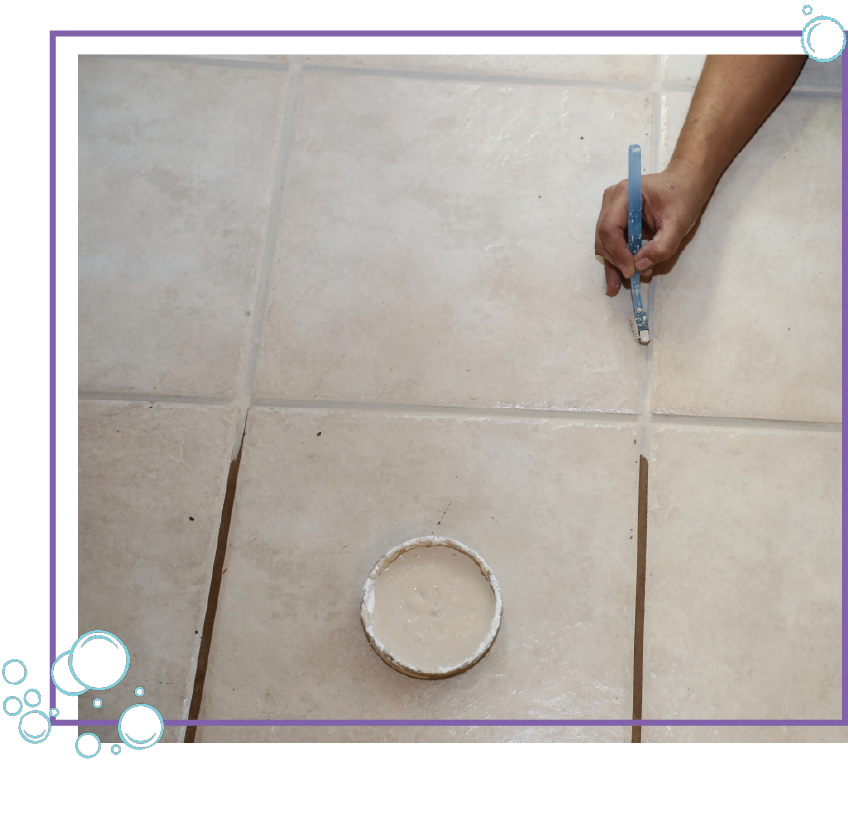Our frequently asked questions section covers some of the most common inquiries our team of grout specialists receives. Some are specific to Central Florida, most are questions any homeowner might have. Read through these to help you understand the grout cleaning and restoration process. Then, contact us to learn more about what Mrs. Grout can do to make your floors like new again.
What is Tile Grout?
Grout is a combination of cement, sand, and rock that is often dyed a specific color to match different shades and patterns of tile. When a tile is applied to a floor or wall, it is set in place using an adhesive. It is necessary to leave joints in between the tiles to allow the adhesive to dry and the moisture to escape. This drying process can take up to 30 days to completely cure, requiring the use of a porous grout to fill the joints and strengthen the floor or wall. The porousness in the grout allows the moisture to escape from the adhesive and prevents the tile from buckling.
What type of grout do I have?
There are two major types of grout, sanded and unsanded.
Sanded grout is generally used for wider grout lines and on larger floor areas. This grout has a sandy rock-like feel and when it is cleaned properly, the pores are opened allowing for color or clear protective sealant to be applied.
Unsanded grout is generally used for tighter grout lines and on shower walls and floors where smaller tiles are installed. This grout has a smooth feeling to it and usually cannot be color sealed due to the lack of pores. However, a clear protective sealant can be used.
Why does grout get dirty?
Grout is like a sponge with thousands of little holes in it.
The same porous properties that allow moisture to escape after tile installation will absorb dirt stains and spills. This can cause the grout to become stained or discolored. Tile is very easy to clean and maintain using a mop and a basic solution of water and a mild detergent. During the process of mopping the tile, the mop gets dirty which results in the spreading of dirty water throughout the grout. The grout, being sponge-like, immediately absorbs all the dirty water. Every time a tile floor is mopped, the grout will become one shade darker than it was previously. It is typical for homeowners who mop their floor often to have dirtier, darker grout lines. More often than not- the harder you try to clean the grout, the dirtier it gets. Instead of mopping with lots of water, try following our tips for keeping tile floors in great shape.

We’ll Take Care Of Your Dirty Grout For You!

How do you clean tile grout lines?
Unfortunately, there is no method to clean grout lines because the stains and discoloration are embedded deep throughout the grout lines. Using a store-bought grout cleaner, steam cleaner, magic eraser, etc. are all viable options for a short-term solution for dirty grout. These techniques will allow you to remove the surface dirt and possibly brighten the grout by several shades. The problem with most grout cleaners and steam cleaners is that they are so aggressive that they actually break down the grout. This makes the grout softer and more porous allowing the stains and discoloration to come back faster. The National Tile and Stone Association of Arizona released a report saying that steam cleaning and strong chemicals are improper grout cleaning methods and will void grout manufacturer warranties.
Should I choose clear grout sealants or colored ones?
CLEAR PROTECTIVE SEALANTS:
All clear sealers regardless of which chemical it is will turn yellow over time. Some sealers will last longer than others but all clear sealers will have to be periodically reapplied. Reapplying the clear sealer is not as simple as putting on a second coat every couple of years. The original coat of sealer that has turned yellow has to be completely stripped from the grout prior to applying the new coat of sealer. Grout color sealers will not turn yellow over time because of the pigments and dyes that are used to color them. If a grout color sealer begins to break down or deteriorate over time it can be reapplied directly over the old color sealer without having to strip the floor.
COLOR PROTECTIVE SEALANTS:
Whether the grout is brand new or it has just been cleaned, the grout will never be perfect and will always have some discoloration. Applying a clear sealer will not change the appearance of the grout and will simply seal what is already there. It is physically impossible to remove deeply embedded stains from grout without actually removing and replacing the grout. Even brand new grout tends to have stains and discoloration due to the dirt in the air and water. When the grout is being applied to a new tile floor, it typically takes several different batches to finish. Every time a different batch is made, the color can vary slightly causing an uneven multicolored look. Using a colored grout sealer will allow the grout to be completely re-colored to a truly brand new, even look. It does not matter how discolored or stained the grout is prior to the color sealing, color sealers will cover the discoloration much like painting a wall.
Can my grout be repaired?
Over time, unsealed grout can break down and deteriorate from a number of causes such as moisture, settling or movement, chemicals, aggressive cleaning tactics, and so on. Just because there are places in your tile that have missing, cracked, or deteriorating grout, that does not necessarily mean all the grout must be repaired. There are some rare cases where the grout must be completely replaced but the majority of the time, it simply needs to be repaired. Grout repair can be done using several different methods and products depending on the issue and condition of the grout. If crumbling, those sections can be repaired with additional grout or grout-caulk. Good grout should never be removed or completely replaced.
Should I replace my grout lines?
No! Replacing the grout on a tile floor is something that should never be considered unless the grout is badly deteriorated or falling out. Removing solid grout lines is very tedious, messy, back-breaking work that often results in the breaking or scratching of the tiles. If someone is successful in removing all the grout lines and replacing them with new grout, which is highly unlikely, you will still be in the same predicament a month later with dirty, discolored grout lines.
Should I replace my tile?
Often tile floors and walls have one or more tiles that have become scratched, chipped, or cracked. Replacing a tile is something that should only be performed by a professional with experience in tile replacement. The entire contents of the “bad” tile must be removed including all the old adhesive to prevent the new tile from sitting up high above the rest of the floor. Replacing tiles without the proper training and knowledge will result in several additional broken or chipped tiles.

Need Help Deciding How to Handle Your Grout?

Do I need a complete shower restoration?
Complete shower restorations refer to the total cleaning and restoring of tile in the shower and tub area. All the leaks are fixed, the tile and grout are cleaned and color sealed, and the joints are appropriately sealed with silicone. A complete shower restoration will result in a “brand new” shower and tub surround.
SHOWER MOLD AND MILDEW
Mold and mildew are very common in every shower or tub surround. Mold and mildew are caused by excessive moisture that does not dry. Although the two can grow in any wet environment, it is most often a result of a poorly ventilated area or cracks, holes, or voids that trap water.
How do I remove mold and mildew from my shower and bathtub?
Mildew can easily be removed by spraying a mildew remover (bleach) solution and allowing it to sit on the mildew until it is gone or cutting out and removing the mildew. However, the downside of this is that bleach and other acidic cleaners when used over time will break down and erode the grout lines. The only way to truly remove the mold and/or mildew is to remove the infected areas of caulk, silicone, or grout, treat it for mold, and then replace it. Otherwise, the mold will return in the same spot unless the spores are killed.
What is soap scum?
Soap scum is present in every shower and bathtub that has soap being used in it. Soap scum is a light film of soap that builds up on the tile and grout as it is being rinsed from your body. Soap scum typically appears as a dull white film but can be different colors based on the soap. Soap scum can be removed in most cases but may need a professional in extreme cases. Soap scum on shower doors requires a specialty cleaner and treatment process.
How do I remove soap scum?
Soap scum can be removed by several different products and techniques. There are several different brands of soap scum cleaners available at various retail stores. You will want to liberally spray the soap scum down with the cleaner and allow it to sit and soften the area. Once the soap scum is softened, generously apply another round of cleaner and scrub the area with a scour pad. To prevent soap scum build-up spray the shower walls down at least once a week with soap scum remover after you’re done showering and allow it to dry with the shower.
What role do shower and bathtub caulking and silicone play in mildew prevention?
Many showers and bathtubs require a bead of silicone around joints and edges to waterproof the area. Caulk should never be used in a shower or bathtub. Caulk is intended for windows and doors while silicone is intended for showers and bathtubs. If mildew is present in the silicone it means that water is penetrating in or behind the silicone and it needs to be completely removed and reapplied.
How do I care for my shower after the Mrs. Grout restoration process?
First, you will need to allow your shower to fully dry. The amount of time this takes varies depending on the package you chose. When you’re ready to begin daily cleaning, we recommend using a non-alkaline cleaner. For deep cleaning, we recommend de-greasers like Mr. Clean. Please avoid harsh chemicals like acid cleaners on your restored tile and grout since they can remove the protective sealant.
Most importantly, allow for good air circulation so the shower can dry completely between uses. This will help preserve your like-new finish for longer.








